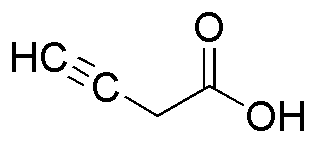3-Butynoic acid is widely utilized in research focused on:
- Organic Synthesis: This compound serves as a key intermediate in the synthesis of various organic compounds, including pharmaceuticals and agrochemicals, allowing for the development of new drugs and crop protection agents.
- Polymer Production: It is used in the production of specialty polymers, enhancing properties such as flexibility and durability, which are crucial in industries like automotive and packaging.
- Flavor and Fragrance Industry: 3-Butynoic acid is explored for its potential use in creating unique flavor profiles and fragrances, appealing to food and cosmetic manufacturers looking for innovative products.
- Biochemical Research: Researchers utilize this compound to study its effects on biological systems, contributing to advancements in biochemistry and molecular biology.
- Analytical Chemistry: It is employed as a standard in analytical methods, helping laboratories ensure accuracy and reliability in chemical analysis and quality control processes.
General Information
Properties
Safety and Regulations
Applications
3-Butynoic acid is widely utilized in research focused on:
- Organic Synthesis: This compound serves as a key intermediate in the synthesis of various organic compounds, including pharmaceuticals and agrochemicals, allowing for the development of new drugs and crop protection agents.
- Polymer Production: It is used in the production of specialty polymers, enhancing properties such as flexibility and durability, which are crucial in industries like automotive and packaging.
- Flavor and Fragrance Industry: 3-Butynoic acid is explored for its potential use in creating unique flavor profiles and fragrances, appealing to food and cosmetic manufacturers looking for innovative products.
- Biochemical Research: Researchers utilize this compound to study its effects on biological systems, contributing to advancements in biochemistry and molecular biology.
- Analytical Chemistry: It is employed as a standard in analytical methods, helping laboratories ensure accuracy and reliability in chemical analysis and quality control processes.
Documents
Safety Data Sheets (SDS)
The SDS provides comprehensive safety information on handling, storage, and disposal of the product.
Product Specification (PS)
The PS provides a comprehensive breakdown of the product’s properties, including chemical composition, physical state, purity, and storage requirements. It also details acceptable quality ranges and the product's intended applications.
Certificates of Analysis (COA)
Search for Certificates of Analysis (COA) by entering the products Lot Number. Lot and Batch Numbers can be found on a product’s label following the words ‘Lot’ or ‘Batch’.
*Catalog Number
*Lot Number
Certificates Of Origin (COO)
This COO confirms the country where the product was manufactured, and also details the materials and components used in it and whether it is derived from natural, synthetic, or other specific sources. This certificate may be required for customs, trade, and regulatory compliance.
*Catalog Number
*Lot Number
Safety Data Sheets (SDS)
The SDS provides comprehensive safety information on handling, storage, and disposal of the product.
DownloadProduct Specification (PS)
The PS provides a comprehensive breakdown of the product’s properties, including chemical composition, physical state, purity, and storage requirements. It also details acceptable quality ranges and the product's intended applications.
DownloadCertificates of Analysis (COA)
Search for Certificates of Analysis (COA) by entering the products Lot Number. Lot and Batch Numbers can be found on a product’s label following the words ‘Lot’ or ‘Batch’.
*Catalog Number
*Lot Number
Certificates Of Origin (COO)
This COO confirms the country where the product was manufactured, and also details the materials and components used in it and whether it is derived from natural, synthetic, or other specific sources. This certificate may be required for customs, trade, and regulatory compliance.


